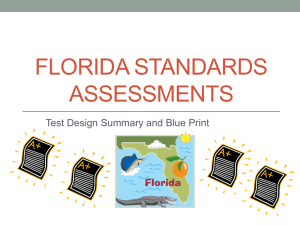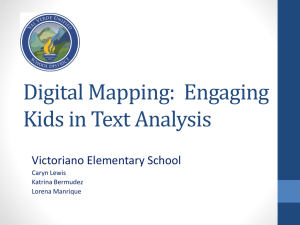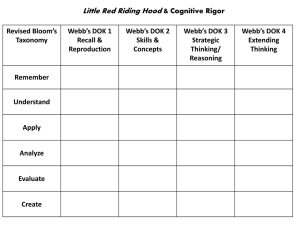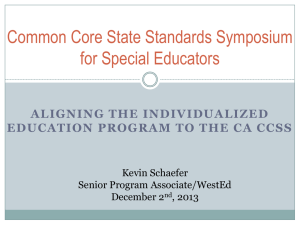Depth of Knowledge Assessments - Roseville City School District
advertisement
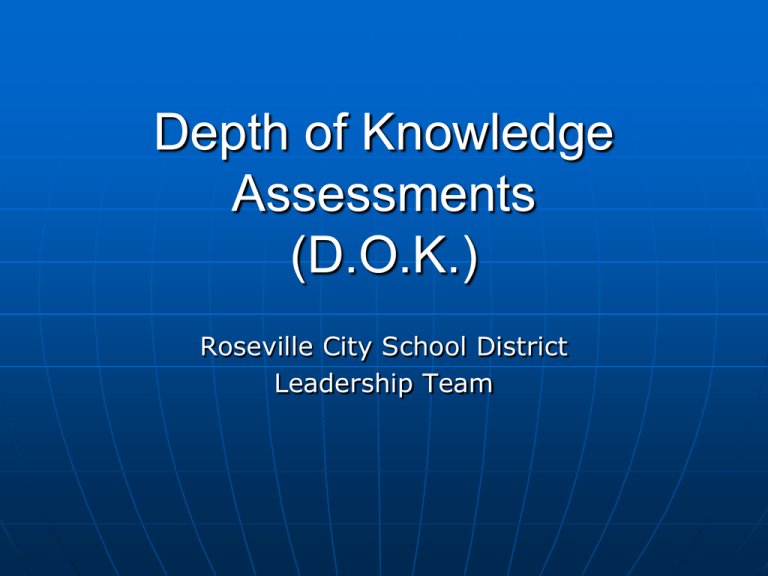
Depth of Knowledge Assessments (D.O.K.) Roseville City School District Leadership Team Depth of Knowledge (D.O.K.) Measures the degree to which the knowledge elicited from students on assessments is as complex as what students are expected to know and do as listed in the state standards. What Do Depth of Knowledge Assessments Accomplish? DOK assessments are a mechanism to ensure that the intent of the standard and the level of student demonstration required by that standard match. Provides cognitive processing ceiling (highest level students can be assessed) for item development. Where Did D.O.K. Come From? Developed by Dr. Norman Webb, senior research scientist at the National Institute for Science Education. The Depth of Knowledge conceptual framework forms the basis for development of Common Core Assessments. How Does D.O.K. Work? Depth of Knowledge is broken into 4 levels. Level One is the most basic level, essentially the “definition” stage. As the levels increase, students must demonstrate increasingly complex mental strategies. Higher levels of DOK require that students solve problems in new and creative ways, and allow for multiple solutions to solve those problems. Levels of D.O.K. LEVEL ONE - RECALL • Recall of a fact, information, or procedure LEVEL TWO – SKILL/CONCEPT • Use information or conceptual knowledge LEVEL THREE – STRATEGIC THINKING • Reasoning, developing a plan LEVEL FOUR – EXTENDED THINKING • Requires an investigation, collection of data and analysis of results D.O.K. Compared to Bloom’s Bloom’s taxonomy level of difficulty is determined by the verb. DOK’s level of cognitive demand is determined by the context of how the verb is used and the depth of thinking required. What comes after the verb is more important that the verb itself. Same Verb – Three Different Levels DOK 1 - Describe three characteristics of metamorphic rocks. DOK 2 – Describe the difference between metamorphic and igneous rocks. DOK 3 – Describe a model you might use to represent he relationship that exists within the rock cycle. BLOOM’S TAXONOMY KNOWLEDGE “The recall of specifics and universals, involving little more than bringing to mind the appropriate material” COMPREHENSION “Ability to process knowledge on a low level such that the knowledge can be reproduced or communicated without a verbatim repetition.” APPLICATION “The use of abstractions in concrete situations.” ANALYSIS “The breakdown of a situation into its component parts.” SYNTHESIS AND EVALUATION “Putting together elements & parts to form a whole, then making value judgments about the method.” WEBB’S DOK RECALL Recall of a fact, information, or procedure (e.g., What are 3 critical skill cues for the overhand throw?) SKILL/CONCEPT Use of information, conceptual knowledge, procedures, two or more steps, etc. STRATEGIC THINKING Requires reasoning, developing a plan or sequence of steps; has some complexity; more than one possible answer EXTENDED THINKING Requires an investigation; time to think and process multiple conditions of the problem or task. D.O.K. is not about difficulty… Difficulty is a reference to how many students answer a question correctly. Same DOK, Different Level of Difficulty • Level 1 DOK - Who is the current President of the United States? • Level 1 DOK – Who was the 19th President of the United States? DOK 1 + DOK 1 + DOK 1 = DOK 1 D.O.K. is about complexity… The assessment question determines the level of cognitive demand, not the student work. Which Level Am I? Label locations on a map. Design and mathematical model to inform and solve a practical or abstract situation. Identify and summarize the major events, problem, solution and conflicts in a literary text. Analyze the interrelationships among elements of the text (plot, subplots, character, setting). Which Level Am I? Explain, generalize, or connect ideas, using supporting evidence from the text or from other sources. Locate information to answer questions related to explicit or implicit central ideas in informational texts. Identify or describe character, setting, and sequence of events. Compare or analyze multiple works from the same time period or same genre. Resources Next Steps Begin D.O.K. discussions at your site Present matrix and begin to provide opportunities to articulate around Depth of Knowledge assessments • Hess Cognitive Rigor Matrix • Webb’s Depth of Knowledge Levels • Little Red Riding Hood & Cognitive Rigor Next Steps – Leadership Team Review Sample Assessments • Reading – 4th • Reading – 7th • ELA – 3rd – Constructed Response • ELA – 7th – Constructed Response • Math – 3rd – Constructed Response • Math – 7th – Constructed Response Questions?






